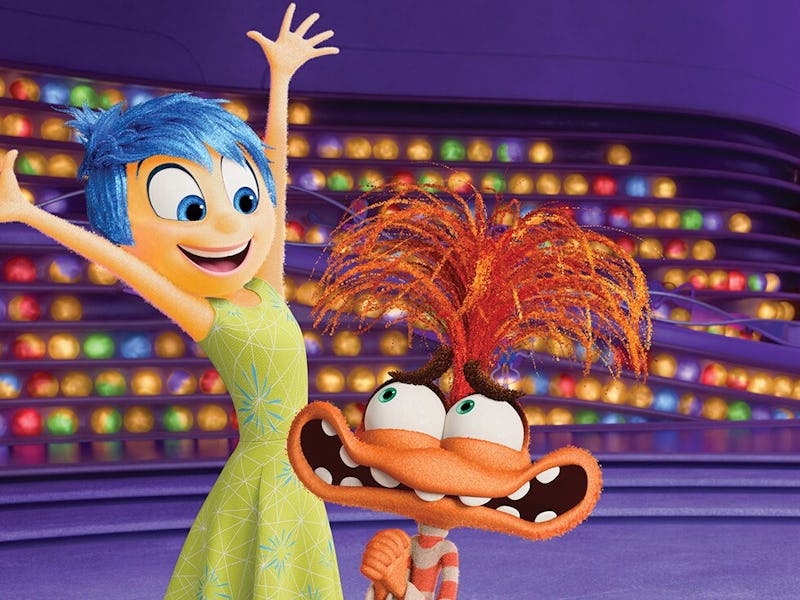Inside Out 2 is Dealing With a Lot of Feelings
Pixar’s sequel recaptures just some, but enough, of the magic of the original.

As Pixar, which distinguished itself from the start as a purveyor of delightfully and movingly original animated features (and proved with last year’s Elemental that it still has that touch), now seems equally devoted to sequelizing all its past triumphs, Inside Out 2 was a cause for both anticipation and apprehension. With its note-perfect evocation through personalization of the core emotions operating within the psyche of 11-year-old Riley, and one classic tearjerker of a scene, 2015’s Inside Out was an especially tough act to follow, even as it ended with hints of a potential second chapter: The new Puberty button on the emotions’ upgraded console and Joy’s closing line, “Riley’s 12 now. What could happen?”
The answer to that question in Inside Out 2, which rejoins Riley (Kensington Tallman) as she turns 13, is: plenty. The squabbly yet smoothly running Headquarters of the girl’s mind is disrupted by that Puberty alarm going off, and a destructive/reconstructive incursion by those blobby little workers, making way for the arrival of new emotions. Joining Joy (Amy Poehler), Sadness (Phyllis Smith), Anger (Lewis Black), Disgust, and Fear (the latter two performed by Liza Lapira and Tony Hale, smoothly taking over for Mindy Kaling and Bill Hader) are the quartet that have so much sway over young teen experience. Ennui (Adèle Exarchopoulos), Embarrassment (Paul Walter Hauser), Envy (Ayo Edebiri), and especially Anxiety (Maya Hawke) have been visually conceived and voiced just as amusingly as the first team. With her wide eyes and explosion of frizzy hair making her somewhat resemble an electrocuted troll doll, Anxiety is a living burst of manic energy who quickly bids to take control of Riley’s actions.
The new group of emotions, Ennui (Adèle Exarchopoulos), Embarrassment (Paul Walter Hauser), Envy (Ayo Edebiri), and especially Anxiety (Maya Hawke), are a welcome addition.
And Riley has quite a bit to be anxious about. A winning middle-school hockey player, she has just been accepted to a three-day summer hockey camp with BFFs and teammates Bree (Sumayyah Nuriddin-Green) and Grace (Grae Lu) when they confess that they’ll be going to a different high school than Riley. That camp is overseen by the coach (Yvette Nicole Brown) of the Firehawks, who play for Riley’s destination school, and whose star player Val Ortiz (Lilimar) is Riley’s idol. And so Anxiety begins guiding Riley with the goal of impressing Val and the coach, to assure her a successful and happy future, even as it means neglecting the friends she’s grown up with. This throws the “sense of self” that Joy has carefully cultivated for Riley, its core mantra being “I’m a good person,” out of whack, and when it is literally sent to the back of Riley’s mind, Joy and her original teammates must trek through the girl’s colorful mental landscape to retrieve and restore it.
Thus, Inside Out 2 adopts one of the time-honored tenets of adolescent-oriented storytelling: Will its young heroine reshape herself to be the person she thinks other people want her to be, or will she make the right decision to be her true self? If there’s a familiarity to this overall arc that keeps this sequel from being the imaginative revelation the first Inside Out was, it’s also true that this tale isn’t usually told with so many vivid and funny details. Along with the iconography we remember from the original, plus little notes like Riley’s dislike of broccoli, director Kelsey Mann, screenwriters Dave Holstein and Meg LeFauve and their team of digital wizards introduce us to a number of fun new environments. Animation buffs will especially enjoy a self-reflexive scene involving a room full of those little workers being directed by Anxiety to draw pictures that will influence Riley’s thoughts. We also meet several entertaining, fresh subsidiary characters, including a few rendered via older-fashioned animation whose particulars shouldn’t be spoiled here, and one more emotion who tries to take part in the proceedings before it’s her time to join in.
Inside Out 2 is a much busier, much less graceful, film than its predecessor.
There are, in fact, an awful lot of characters bouncing around Inside Out 2, and while they assure that there’s often something funny going on, it means that this is a more busy film than its graceful predecessor. And certainly, there’s no moment here that will seize your heart so completely as the fate of Bing Bong in the original. Yet it remains consistently involving as both Riley and Joy navigate the onset of new emotions, and while Anxiety has been envisaged in comedic terms, the movie doesn’t sugarcoat anxiety as it is experienced — increasingly so in modern times — by young people. Nor does the story come to as simple a resolution as one might expect, offering a message that’s hopeful while respecting the realities of life.
It is in its dealing with such thoughtful themes through the prism of an antic animated comedy, making them accessible to a family audience, that Inside Out 2 proves to be an honorable follow-up to its modern-classic inspiration.